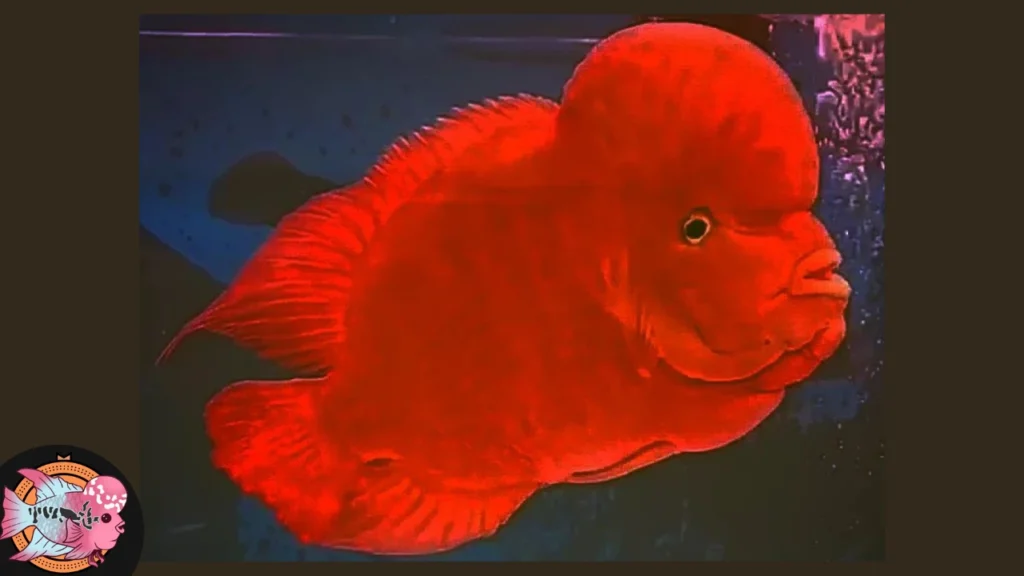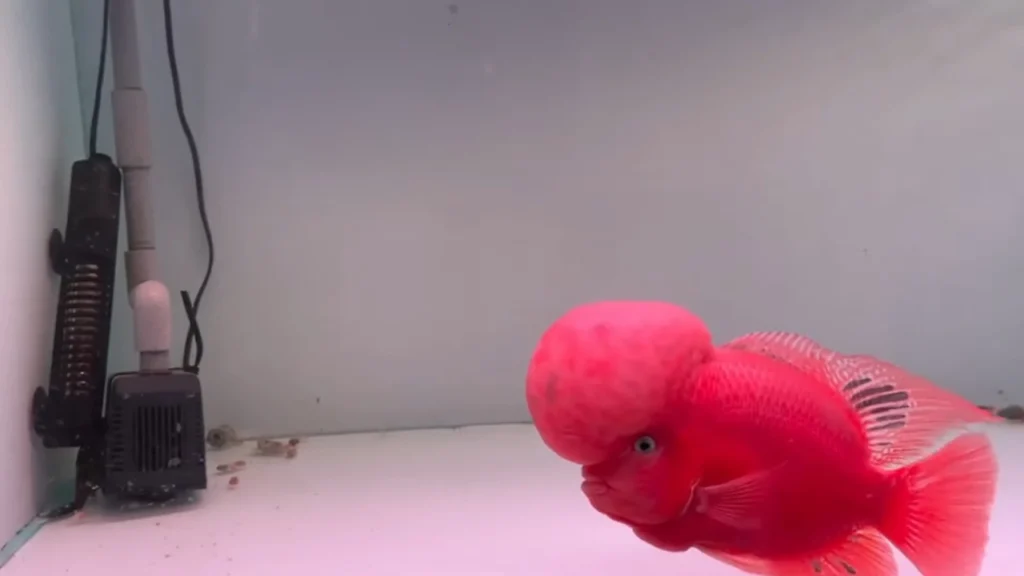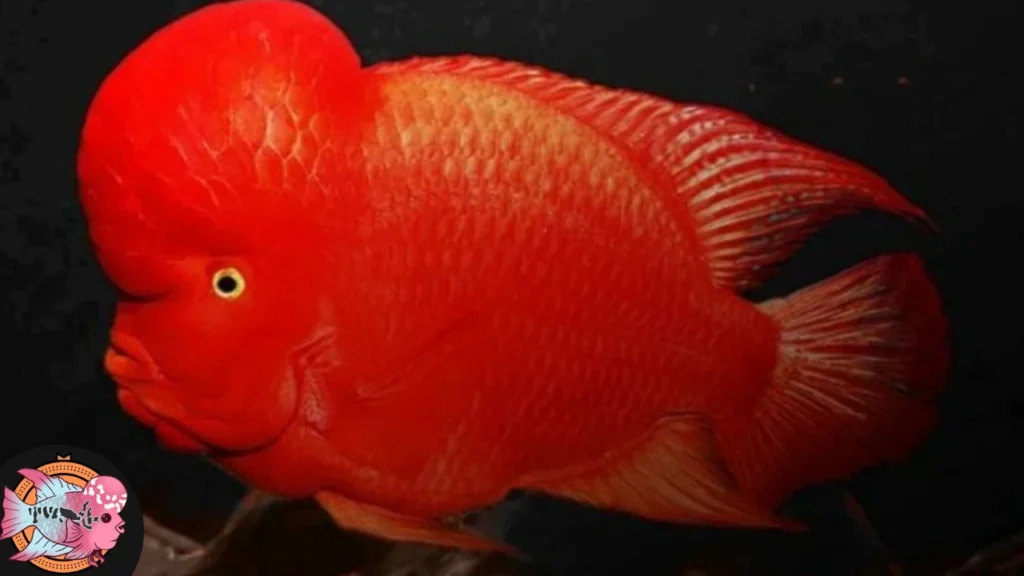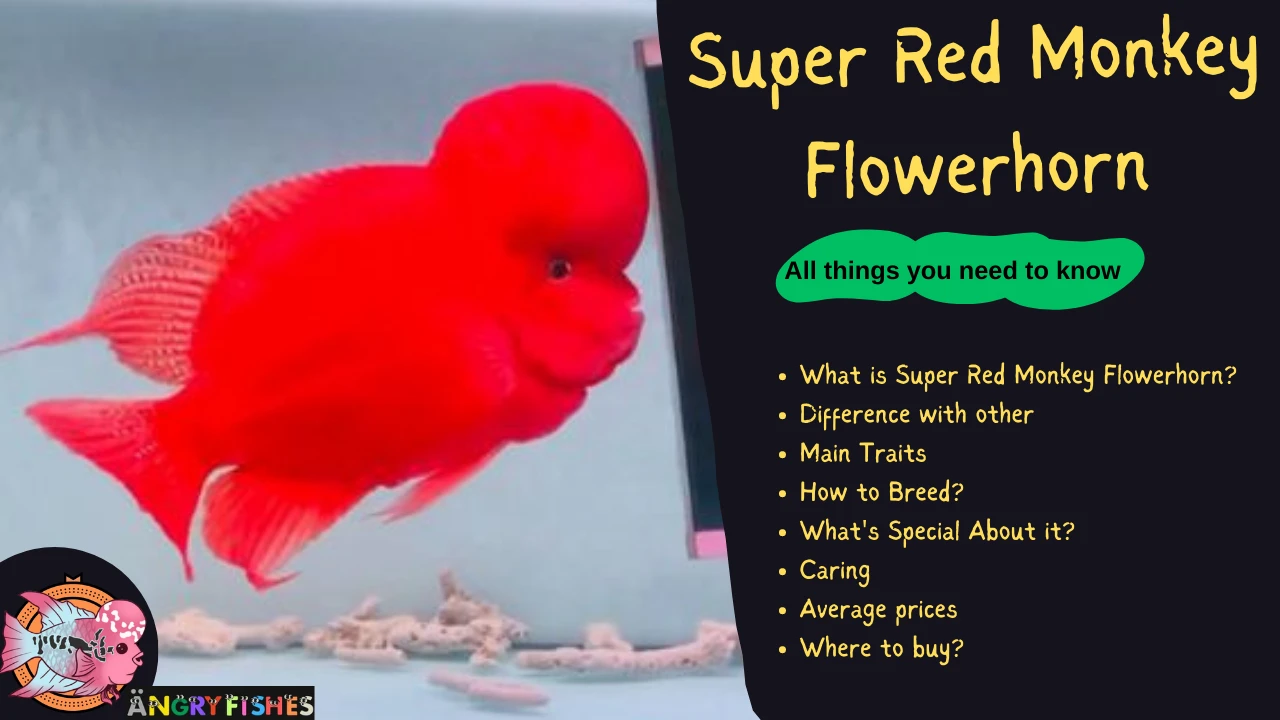Many people appreciate having unique items in their possession, and when it comes to flowerhorn hobbies, a unique and high-quality breed is highly sought after. Among the various types of flowerhorn cichlids, the Super Red Monkey flowerhorn stands out as a unique and stunning breed. Join us as we explore everything you need to know about its growth stages, temperament, breeding challenges, care routines, feeding strategies, pricing, and more.
Welcome To AngryFishes, I’m Thaha, let’s get started.
What is Super Red Monkey (SRM) Flowerhorn?
It is preferable to inquire about how SRM flowerhorns came to be and what their traits are, rather than simply asking what an SRM flowerhorn is. Drawing from my years of experience in raising flowerhorn, I will share the insights I’ve gained along the way. Many new hobbyists confuse the SRM FH with the deviated strain of Kamfa due to their similar facial appearance, but this assumption is completely incorrect.

This variety is entirely different from other types. Super Red Monkey flowerhorn do not have any pearl markings, do not possess any dark scales (whether grown or faded), have high interaction with humans, and their body shape differs from other types.
Breeding the SRM from its ancestors is not an easy task like how you breed flowerhorns. It takes several years to achieve good results, and most of the time, success is not guaranteed. The reference chart for the origin of the SRM flowerhorn is attached below.

Difference between SRD and SRM flowerhorn:
Many beginner hobbyists confuse themselves with the Super Red Monkey flowerhorn variety and the Super Red Dragon variety. Some also mistake it for the Golden Monkey breed. It’s important to understand the major differences between them.
Scammers on the internet can easily deceive you by sending Super Red Dragon flowerhorns instead of Super Red Monkey ones, so the table and accompanying image will help you address these issues.
Additionally, you can refer to our Super Red Dragon flowerhorn article after reading this one for further clarification.
| Super Red Monkey FH | Super Red Dragon FH |
| Completely Red | It possesses different color shades, but the base will be red |
| No pearl marking | Will have pearl markings |
| Possesses phases like fading stages | No fading stages |
| High maintenance | Comparatively low maintenance |
| White eyes | Red or yellow eyes |
| Hammer type Kok | Normal as usual-type Kok |
| Most male SRM flowerhorn are infertile | Mostly fertile |
| High priced breed | Relatively cheap |


Main Traits of Super Red Monkey Flowerhorn:

Its Hammer Kok:
The hammer-type Kok is one of the unique and attractive features of the Super Red Monkey FH. The Kok (head) will be oblong in an oval shape rather than a ball shape. Nowadays, it can also be seen in some Kamfa breeds, but the combination of thick reds in the skin along with an attractive hammer-type head is a dream and buying point for most flowerhorn keepers, including myself 🙂
Color:
Color is another specialty of the SRM breeds. However, achieving the potential colors of your SRM flowerhorn at 6 to 12 months requires a lot of patience, care, and trust in the process.
If you are purchasing an already faded, groomed SRM, it means you have been drawn to its thick red colors running through its skin, compelling you to spend hours standing or sitting before your flowerhorn tank.
Thus, color is one of the coolest traits of SRM flowerhorns.

Face shape:
The face shape somewhat resembles that of Golden Monkey FHs, as it looks like a monkey’s face, which is why the name was adopted for this variety. It is somewhat similar to King Kamfa‘s face, but along with the hammerhead and color, the overall beauty of the SRM is enhanced due to this resemblance.
Growing stages of SRM flowerhorn:
The one special thing about this type of FH and Golden Monkey FH is FADING. The SRM flowerhorn will not display its full color until it is completely groomed and provided with suitable conditions. However, this process takes time.
Most people see the completion of fading around the 12-14-month range, but some may experience it after 18 months as well, as it reaches 1.5 years of age. The flowerhorn hobbyist needs to have strong patience to allow the process to be complete without losing confidence.

Once the SRM flowerhorn is completely faded, it will look like swimming red gold in your tank. I say this because faded SRM flowerhorns are more costly and rare in the flowerhorn market. In such cases, your flowerhorn becomes an asset.
Grooming techniques for SRM:
This is a separate and lengthy topic; I will create a separate post for this. Briefly, grooming is essential to enhance your SRM flowerhorn’s appearance, including its Kok, color, and size. The major grooming methods suggested for Super Red Monkey flowerhorns are:
- Mirror Grooming.
- Adding Tankmates.
- Follow the Finger.

Breeding Difficulties in SRM flowerhorn:
Most Super Red Monkey flowerhorns are infertile, up to 99% of them. This is because this type of flowerhorn is crossbred multiple times over several generations to achieve the desired quality in Kok, color, and size, but the compromise is often infertility.
While females in Super Red Monkey are fertile and capable of laying eggs and breeding with other male flowerhorn types, the male SRM flowerhorn is mostly sterile. If you happen to have a pair of SRM with a fertile combination, it’s considered a jackpot.
Region-wise Price of SRM Flowerhorn:
| Country | Price |
|---|---|
| India | Starts with 3000 INR (unfaded fry, 2.5 inch) |
| United States | Starts with 300 $ (depends on quality) |
| Philipines | Starts with 250 $ (depends on quality) |
| Malaysia | Starts with 250 $ (depends on quality) |
| Singapore | Starts with 200 $ (depends on quality) |
| Australia | Starts with 200 $ (depends on quality) |
Overall care for SRM flowerhorn Cichlids:
The overall care for Super Red Monkey flowerhorns is similar to that of other flowerhorn fish care guides, but the most important aspect is the grooming stage. It’s crucial to maintain crystal-clear water in your SRM tank, along with a powerful filtration system to regulate nitrate and ammonia levels.

Additionally, a reliable heater setup to maintain a constant temperature between 26-29°C, along with a special tank, can contribute to good care.
Feeding special foods designed for SRM flowerhorns is a great idea to maintain their colors, Kok, and overall health. It’s also recommended to have deworming sessions once every 2 months.
To Sum up:
I truly hope that you found some useful information on the Super Red Monkey flowerhorn. Many of the topics I’ve covered here are either not widely discussed or are scattered across various blogs. If you have any doubts or suggestions, please share them in the comments section.
Additionally, I’m planning to create a separate post on “Grooming Techniques for Super Red Monkey Flowerhorn to Fade,” so feel free to add your suggestions if you also own an SRM. You can also reach out to me via the Contact Us section.
Thank you so much for staying till the end. Don’t forget to sign up for our newsletters for weekly updates. Goodbye for now, and I look forward to seeing you all on new interesting posts. Signing off, Thaha.
Frequently Asked Questions (FAQs)
1. Why is my Super Red Monkey flowerhorn not showing its red color yet?
SRM flowerhorns go through a fading process, and their full red coloration typically doesn’t appear until 12 to 18 months of age. This fading depends heavily on proper grooming, water quality, diet, and overall care. If your fish is still young or not in optimal conditions, it’s completely normal for it to look pale or dull. Patience and consistent grooming are key to achieving its full color potential.
2. Can Super Red Monkey flowerhorns breed successfully?
Male SRM flowerhorns are mostly infertile, with over 90% being unable to fertilize eggs due to the extensive crossbreeding used to achieve their unique traits. Females, however, are often fertile and can breed with other compatible male flowerhorns. If you’re lucky enough to have a fertile SRM pair, it’s considered extremely rare and valuable.

